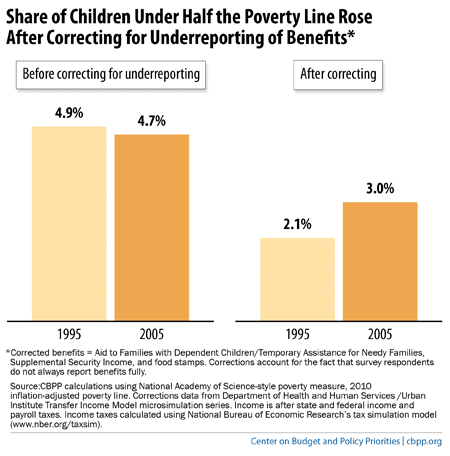off the charts
POLICY INSIGHT
BEYOND THE NUMBERS
BEYOND THE NUMBERS
Fewer Poor Children Under Welfare Law, But More Very Poor Children
Receive the latest news and reports from the Center
There are fewer poor children in America but more very poor children since policymakers dramatically shifted low-income assistance from non-working families to working families in the mid-1990s, our new report explains.
We estimate that the share of children in deep poverty — with family income below half of the poverty line — rose from 2.1 percent to 3.0 percent between 1995 and 2005, after correcting for households’ underreporting of safety net benefits in Census surveys (see graph). The number of children in deep poverty climbed from 1.5 million to 2.2 million.

These findings are consistent with other research, such as a study finding a significant rise in the number of households with children with monthly cash incomes equivalent to less than $2 per person per day — a standard of poverty more associated with developing countries.
The 1996 welfare law replaced Aid to Families with Dependent Children (AFDC), which had chiefly served families with little or no earnings, with Temporary Assistance for Needy Families (TANF), which offers less assistance and includes stricter work requirements and time limits. At the same time, policymakers expanded assistance for moderate-income working families, such as by strengthening the Earned Income Tax Credit (EITC) and medical and child care programs and creating and later expanding the Child Tax Credit.
Some data sources don’t show a rise in deep poverty for children, but this appears to reflect their omission of a large share of the income from key public benefit programs. Correcting for this underreporting reduces the deep poverty rate in any given year but reveals the increase in deep poverty over the decade as income from these programs — particularly public assistance (AFDC/TANF) — shrank.
Public assistance kept 2.4 million children out of deep poverty in 1995 but only about 600,000 children in 2005, after correcting for underreporting.
Policymakers need to take account of the significant rise in deep poverty among children as they consider proposals affecting support for poor families, including the poorest families with children.